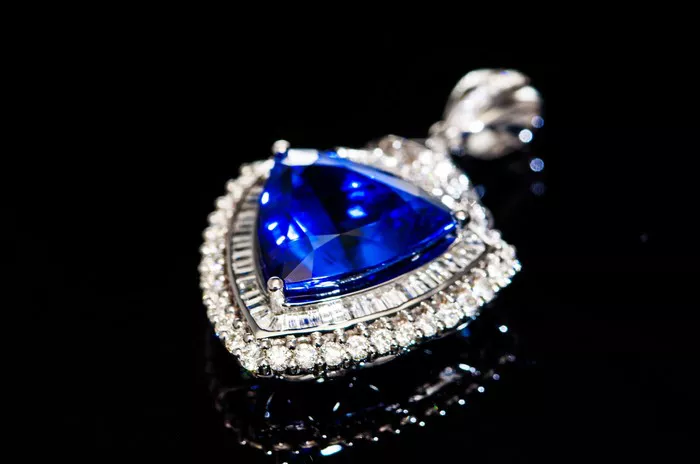Black Star Sapphire, with its captivating asterism, has intrigued gem enthusiasts and collectors for centuries. This unique gemstone is celebrated not only for its beauty but also for its rarity and the intricate processes that give rise to its distinctive star-like patterns. In this article, we will explore the factors that determine the value of Black Star Sapphire, from its geological formation to market demand.
What is Black Star Sapphire?
Black Star Sapphire is a variety of corundum, an aluminum oxide mineral that includes both sapphires and rubies. The defining characteristic of Black Star Sapphire is its star-like pattern, known as asterism. This effect is caused by the reflection of light off needle-like inclusions of the mineral rutile within the sapphire, which are oriented in such a way that they form a star with four, six, or even twelve rays.
Geological Formation: A Dance of Elements
The formation of Black Star Sapphire begins deep within the Earth under high pressure and temperature conditions. Corundum forms in metamorphic rocks, particularly in areas with high aluminum and low silica content. The presence of trace elements such as iron and titanium gives the sapphire its black color, while the rutile inclusions necessary for asterism are also present in the geological environment.
The Journey from Rough to Refined
Mining and extracting Black Star Sapphire is an arduous process. These gemstones are typically found in alluvial deposits, where they have been eroded from their original rock matrix and transported by water. Major sources of Black Star Sapphire include Sri Lanka, Thailand, Cambodia, and certain regions of Africa.
Once extracted, the rough stones are carefully examined. Gem cutters play a crucial role in orienting the stone so that the star pattern will be centered and most visible when the gem is cut into a cabochon (a polished, non-faceted gem). The quality of the cut is vital as it directly affects the visibility and symmetry of the star, impacting the gem’s value.
See Also: What is Star Sapphire?
Assessing the Value of Black Star Sapphire
Several key factors determine the value of Black Star Sapphire:
1. Quality of Asterism
The most critical factor in valuing Black Star Sapphire is the quality of its asterism. The star should be sharp, distinct, and centered when viewed under a direct light source. Ideally, the rays of the star should be evenly spaced and of equal length. The more pronounced and symmetrical the star, the higher the gemstone’s value.
2. Color
While Black Star Sapphires are typically dark, the ideal stones exhibit a uniform, rich black color. Stones with grayish or brownish hues are less desirable. The intensity of the black color can enhance the visibility of the star, making it appear more striking.
3. Clarity and Transparency
Like all gemstones, clarity is an essential aspect of Black Star Sapphire. However, due to the nature of asterism, some inclusions are necessary to create the star effect. Therefore, the value of Black Star Sapphire is not as heavily penalized by inclusions as faceted gemstones might be. Nonetheless, the stone should be free from large cracks or blemishes that could detract from its overall appearance and durability.
4. Size
Larger Black Star Sapphires are rarer and thus more valuable. However, the size must be balanced with the quality of the asterism. A large stone with a weak or poorly centered star will not be as valuable as a smaller stone with a sharp, well-defined star.
5. Cut
The cut of the Black Star Sapphire is crucial in showcasing its star. Stones are usually cut into cabochons, with a high, domed surface to best display the asterism. The skill of the cutter in aligning the star and achieving the right proportions significantly impacts the gem’s final value.
The Role of Treatment and Enhancement
Black Star Sapphires, like many other gemstones, can undergo treatments to enhance their appearance. Heat treatment is commonly used to improve color and clarity. In some cases, diffusion treatment, where elements are diffused into the surface of the stone to enhance color or asterism, may be employed. These treatments can affect the value of the gemstone, typically reducing it compared to a naturally occurring, untreated stone.
Market Demand and Rarity
The value of Black Star Sapphire is also influenced by market demand and its rarity. While not as widely recognized as blue sapphires or rubies, Black Star Sapphires hold a niche but enthusiastic market. Their unique beauty and the rarity of high-quality stones drive demand among collectors and gem enthusiasts.
Investment Potential
Black Star Sapphires can be a sound investment, particularly for those who appreciate their unique aesthetic and rarity. However, as with any gemstone investment, it is crucial to have the stones appraised by certified gemologists and to purchase from reputable sources. High-quality Black Star Sapphires, particularly those with exceptional asterism and color, have the potential to appreciate in value over time.
Conclusion
Black Star Sapphire is a gemstone of extraordinary beauty and uniqueness. Its value is determined by a complex interplay of factors, including the quality of its asterism, color, clarity, size, and cut. While not as universally known as some other gemstones, it holds a special place in the hearts of collectors and enthusiasts.
Understanding the factors that contribute to the value of Black Star Sapphire can enhance appreciation for this remarkable gemstone. Whether you are a collector, investor, or simply someone who admires the beauty of nature’s creations, Black Star Sapphire offers a glimpse into the Earth’s hidden wonders and the intricate processes that bring them to light.
By appreciating the artistry involved in its formation, extraction, and cutting, we can truly value the allure of Black Star Sapphire—a gem that captures the magic of a starry night within its depths.


